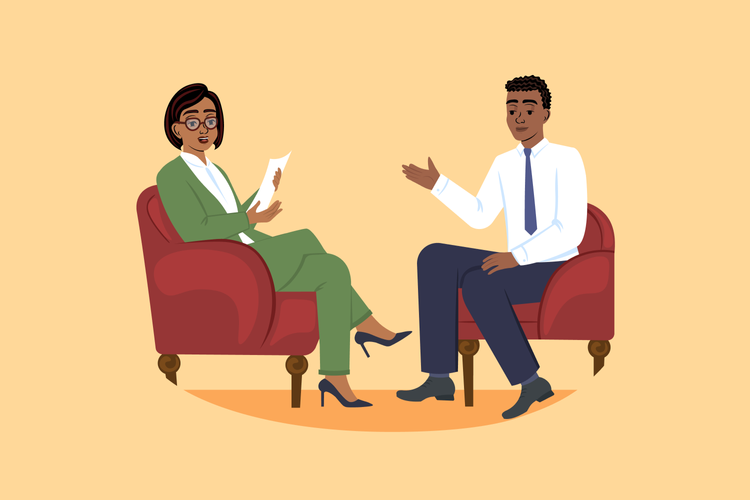How to Think in English: 7 Steps to Perfect Language

Contents
Have you thought about the way you understand or speak English for once? Be honest with yourself and answer the following question truthfully. Do you have to translate everything you hear or say in your head instead of processing it in English? Stop that immediately! It's not effective for you. That's not the way babies learn to understand speech and speak themselves.
Have the thought about starting to think in English ever crossed your mind? Probably, there were a couple of times when you "heard" English thoughts in your head but then went back to your native language. This article will explain why thinking in English is life-changing and give you a step-by-step plan to start thinking in English.
What Is Language Switching, And How It Is Related To Thinking In English
Some people had known two (or even more) languages since birth or when they were kids. We call them bilingual. Such people can understand, speak, write and read in two languages on the same native level. It's cool, right? It sounds like a dream because, unlike you, they didn't need to put any effort into learning those languages. Or did they?
According to the studies, bilingual kids start speaking a little later than monolingual kids. The reason is that their brain needs to build different connections and adjust to thinking in both languages that surround them. Usually, it is typical for kids in Canada, where they speak English and French, in the USA, where on top of English, they speak another language of their ancestors` country, and kids whose parents just decided to raise them bilingual, with or without cultural context.
Every time a bilingual person wants to speak one of their languages, the language switching happens in their head unconsciously. Then, finally, they recognize the language and start using it. But that still requires a lot of control; otherwise, bilinguals can start mixing languages. For example, saying something like "It's mi casa, not yours!" instead of "It's my house, not yours!" If you want to learn more on this topic, read the article "How do bilinguals switch between languages in different interactional contexts? A comparison between voluntary and mandatory language switching," published online by Cambridge University Press.
Now you know what language switching is. But how is it connected with thinking in English? To start thinking in English, you must switch the language in your head. And we are not talking about translating your native language into English in your head here. Instead, pretend that English with limited vocabulary and grammar you know is all you have and start working with that. We will give you recommendations on how to do that in a minute.
How Thinking In English Can Help In Learning The Language
Most likely, at your current level, you tend to translate lots of English speech in your head. Thinking in English leads to more fluency in speaking, writing, and understanding the language. If you want to reach a level of a native speaker of English, you must start thinking in English.
Such skills will help you to internalize language and stop worrying about every little piece of grammar. You will finally be able to feel the language and use it as natives do. Ask an average native English speaker about grammar rules or pronunciation. It's funny, but they have no idea about many things regarding their native language. The reason is that they internalized it since birth.
In addition, thinking in English is an excellent way to practice the language where there is no one to talk to. You always have you.
2
How To Think In English In 7 Easy Steps
If you assume that thinking in English will come naturally, we have bad and good news for you. The thing is that after years of learning English, thinking in it will come naturally eventually. Your brain will adapt to the language step-by-step, and you will stop translating everything, but you will probably desperately search for words and grammar in your head. But you can't call such a way of achieving your goal effortless, right?
So, it turns out that you have to work hard to start thinking in English either way. So, why won't you do it intentionally? We have some recommendations for you on to think in English. Just follow our easy peasy lemon squeezy steps!
Step 1 – Start With One Word
It is much better to begin thinking in English from the beginning of your learning journey. It might seem like you don't know enough words for that, but that's not true. At first, thinking in English starts from single words.
Adults can find memorizing new words in English challenging because they are trying to keep up with translations into their native language. When babies explore the world and hear the language, they don't have anything to rely on except the sense organs. There is no way to translate when you learn your first language ever. Use that principle to start thinking in English. Build an association of everything that surrounds you with English equivalent instead of translating it.
The best way to do it is by using flashcards with images instead of translations and learning from real-life surroundings – objects, phenomena, and actions. You can find flashcards in English learning apps. But that is only the beginning because you must implement those single words in your everyday routine.
First thing in the morning, when you wake up, think that it's "morning." Then go to the bathroom, look at the objects, and name them in your head. It could be something like a toilet paper, a bath, a mirror, a toothbrush, a toothpaste, a cleanser, a serum, etc. You can also leave notes around the house to help build associations and remind you to think in English daily.
Step 2 – Proceed With Easy Sentences
As soon as you succeed with thinking in English in single words, move forward to easy sentences. You can practice with easy sentences wherever you are – at home, at work, on a bus, in a restaurant, or at the beach. Start with simple grammar and tenses. Just don't forget to do it.
We suggest you start with confidence-boosting affirmation in front of the mirror. In such a way, you can kill two birds with one stone. First, look at your reflection and think: "I am beautiful. I am gorgeous. I am divine. I am smart. I am capable. I am strong. I am healthy. I am love".
Then you can move to notice something about other people. Don't be judgmental; see good things. For example, "Trevor looks good in a black jacket" or "Nancy has a nice garden."
Step 3 – Talk To Yourself
In general, talking to yourself is a normal thing for a human being. Previously you were practicing thinking in English in single words and easy sentences. Now you should try to have monologues with yourself. It will help you to get better at English overall. No one can judge you for your mistakes, long pauses, or lack of words here. Your inner world is a safe place for you to think in English.
Let's see some examples of when and where talking in English to yourself can be helpful. For instance, you go grocery shopping and have a list of what you need to buy. Say to yourself/think a short monologue like this: "Okay. I need to buy groceries for the whole week. Let's see what's on my list. Did I forget cash? Oh, I can pay with my phone. I'm fine. So what's on my list today?"
Step 4 – Make Up Imaginary Scenarios In Your Head
We can't tell for everybody, but the author of this article loves to create imaginary scenarios in her head before dates, meeting new people, and important events in general. So it might become a beneficial exercise to start thinking in English.
When you create imaginary scenarios in your head, you try to predict what will happen. So, you can be prepared to talk about the same stuff in English. Also, it helps to look for new words, phrases, and constructions in your thinking which eventually will be displayed in speaking in real life. Isn't it awesome?
Step 5 – Keep A Diary Or A Planner
As a big fan of movies and series, the article's author adores using voice narration in films. It's such a unique reception that shows the character's thoughts when they are not talking to somebody. Usually, filmmakers use voice narration when characters read a letter or write in their diaries or planners. And it is pretty logical.
Why won't you try to do the same? Or, if you already keep a diary or a planner, switch it to English. It's much easier to improve the skill of thinking in English by putting your thoughts on paper. So, for example, plan your day with bullet points and end your day by writing how you felt today in a diary in English.
Step 6 – Learn English With English
Perhaps, it's the best rule for every English learner, especially advanced. When you already have a rich vocabulary and basic grammar knowledge, translation is unnecessary. It is more confusing for your brain to memorize new information and learn something in English. So, stick to English to English dictionaries such as Merriam-Webster Learner's Dictionary, and the process will go faster.
Step 7 – Text In English
The rule sounds like that - when you text someone, you think and talk to yourself in your head. It makes texting a perfect step to start thinking in English. Ask one of your friends to text at least one social media, and you'll benefit. Of course, it shouldn't necessarily be long chats. Start by commenting on funny TikToks that you send each other. Also, you can find a pen pal in one of the apps for chatting that we wrote about recently.
Think In English With Promova
Promova can help you with several steps to start thinking in English, which we suggested above. First of all, you can begin with our flashcards. They were made with cute and unique memorable images to help you build an association with a word or a phrase. That will help you to start thinking in single words and then easy sentences. Second, Promova offers you to learn English with English. All definitions for words and phrases are written in English, all the grammar in videos is explained in English, and all our tutors speak exclusively in English. And last but not least, while you are learning, you can talk to yourself with an inner voice in English. The more practice you get, the better, and the sooner results will become noticeable.
Conclusions
Thinking in English might seem difficult at first, but it's a bearable skill for every English student, regardless of experience and age. You need to follow our easy steps and believe in your progress. It may come later than you expect, but it will come. All you need is to think.
FAQ
How long does it take to start thinking in English?
Switching to thinking in English won't happen in one day. Be ready for that. There is no magic solution for the issue except for hard work and consistency. According to Foreign Service Institute research, it takes 480 hours to reach basic fluency in English. After that amount of learning time, you will be able to think in English more or less fluent. But that is almost your end goal. After a week of everyday practice, you will see progress in your thinking skills in English. Be patient, and don't quit!
What language do bilingual people think?
Bilinguals think in both languages they know, depending on the language context they are operating in. For instance, a kid was raised by parents who spoke two different languages. With every parent, a bilingual person will speak in their language. But if parents between themselves used only one language, more likely, that with both parents the kid would use one common for all of them language.
An interesting fact was detected in the research by Panos Athanasopoulos Professor of Linguistics and English language at Lancaster University. It showed bilinguals behave like two different people using each language. Bilinguals can focus on different things depending on the language. That is why they sort of having different personalities in each of them. Also, that might be a part of cultural adjustment. For example, in English, you should use various forms of words and sentence constructions to sound polite, while in Italy, people say everything exactly the way it is with no second thought.
Does my brain work differently when I think in English?
It is not an easy question that requires a scientific approach to answer it. Technically, it depends on when you started learning English. Bilinguals who picked up a language at a very young age have one area that processes both languages. However, for adult English learners, a separate area develops close to the first. So, thinking in English will involve the work of a slightly different area of your brain.
Is hearing my own voice in my head normal?
It is unlikely that you've read this article out loud. So, we bet you did it with the voice in your head; you can "hear" it this very second. But if you have never read about it, don't freak out – everyone has it. A voice in your head is called the inner voice. According to a study from the Department of Linguistics at the University of British Columbia, your inner speech uses a system mainly employed for processing external speech, which is why you can "hear" your inner voice.




Comments